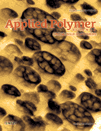Some properties of composites based on vulcanized liquid polybutadiene matrix and inorganic particulate fillers
Abstract
This study is primarily focused on the possibility to use a sulfur vulcanized low-molecular weight polybutadiene with isocyanate end groups in the main chain as a matrix for composite materials reinforced with common inorganic particulate fillers (calcium carbonate, titanium dioxide, titanium dioxide modified with zinc, respectively). The isocyanate groups were used for a preliminary crosslinking of the oligomeric polybutadiene with glycerol as a three-functional crosslinker. The prepared polybutadiene-based polyurethane gel was subsequently vulcanized with sulfur. It has been shown that the vulcanized liquid polybutadiene could be successfully applied as the matrix for composite materials with inorganic filler. The resulting composite materials exhibited enhanced mechanical properties (tensile strength, flexural strength, hardness) and retain a high chemical resistance against hydrolysis and aqueous solutions of chemicals. © 2012 Wiley Periodicals, Inc. J. Appl. Polym. Sci., 2013




